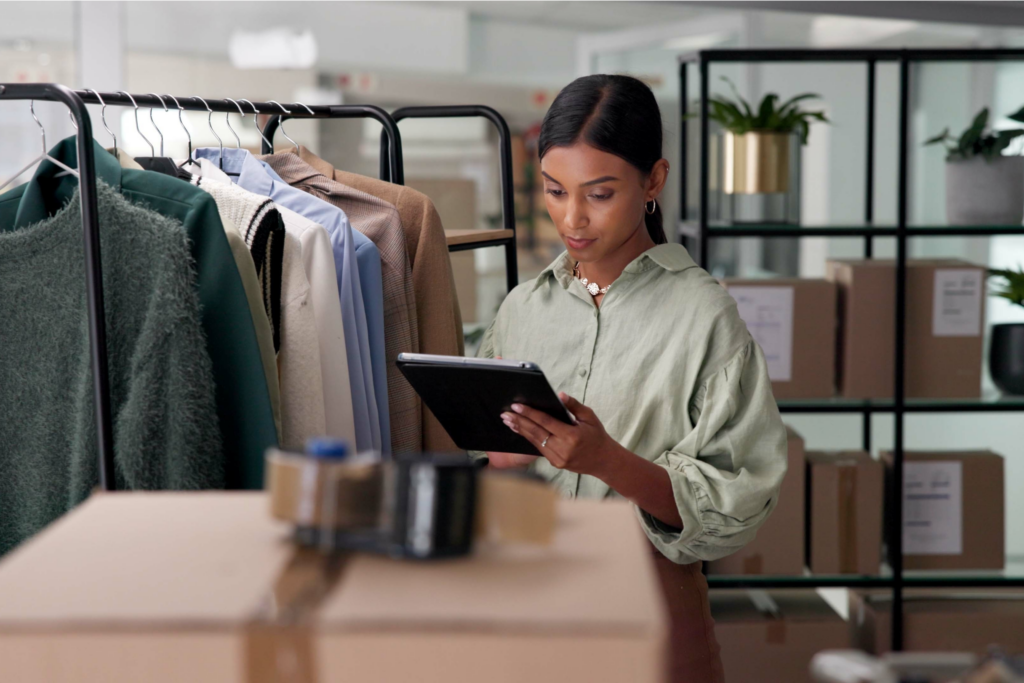Start a print-on-demand business today
A niche is a small, focused segment of a bigger market. Instead of selling to a broad group like travelers, you sell to a smaller group like backpackers on a budget. When you find the right niche, you stand out from competitors, build loyal customers, and grow faster with less effort. In this guide, we’ll explain what a niche is and show you 10 practical examples that get it right.
This post may contain affiliate links, which means we may earn a commission if you make a purchase through those links. This comes at no additional cost to you.
What is a niche market?
A niche market is a smaller segment of a larger market defined by specific needs or interests. Instead of catering to everyone, you target one defined group, making it easier to reach them and stand out from generic alternatives.
10 niche ideas for Print on Demand
Settling on a niche can feel overwhelming, but you don’t have to start from scratch. Here are 10 proven categories with niche ideas to draw inspiration from, plus examples of niche products to sell.
1. Pet owners

Why it works: Pet owners are some of the most loyal and emotionally motivated buyers. They treat pets as family and love spending on items that celebrate that bond. The global pet care industry is expected to reach $273.42 billion in 2025, showing just how strong this market is.
Niche examples: Dog or cat parents, breed-specific communities, rescue supporters
Product ideas:
- Custom pet portrait shirts or mugs
- Custom-shaped pillows
- Breed-specific dog parent hoodies
- Personalized collars or bowls
2. Fitness communities

Why it works: Spending on fitness isn’t limited to gym memberships. People also budget for athleisure and gear that support their lifestyle. Beyond performance, fitness wear has become everyday fashion – leggings, sports tops, and shoes are worn well outside the gym, making it a profitable niche for print-on-demand sellers.
Niche examples: CrossFit athletes, yoga groups, runners, gym culture
Product ideas:
- Sports jerseys
- Reusable water bottles
- Yoga mats
- Training log notebooks
3. Eco-conscious buyers
Why it works: Consumers choose products that align with their values, and sustainability is at the top of the list. People who identify as eco-conscious are willing to pay more for items made from organic or recycled materials and often avoid single-use goods altogether.
Niche examples: Zero-waste shoppers, minimalists, climate activists
Product ideas:
- Organic cotton t-shirts
- Recycled-material notebooks
- Reusable water bottles
- Eco-friendly tote bags
4. Families

Why it works: From baby showers to Mother’s and Father’s Day, family-themed products rank among the top-selling POD items on Etsy and Shopify year-round. They’re highly giftable and easily personalized – and with customization (names, dates, titles) raising perceived value, sellers can set higher margins.
Niche examples: New parents, grandparents, blended families
Product ideas:
- “Mom life” t-shirts
- Personalized baby name onesies
- Family quote wall prints
- Grandparent mugs (“Best Nana Ever”)
5. Gamers

Why it works: Gaming is one of the largest entertainment industries worldwide. Designs inspired by retro games, eSports, or gaming humor resonate because they let people express their identity both online and offline. With millions of potential buyers and a culture built on self-expression, gaming offers strong, ongoing demand for personalized products.
Niche examples: Retro gaming enthusiasts, console collectors, eSports audiences
Product ideas:
- Pixel art t-shirts
- “Insert coin” themed mugs
- Retro gamepad phone cases
- Arcade-style typography posters
6. Meme culture
Why it works: Memes spread fast and hit hard among online communities. People love merch that turns an inside joke into something they can wear or show off. With viral memes driving quick demand spikes, sellers have a chance to capitalize on what’s trending while also building evergreen designs with lasting appeal.
Niche examples: Gen Z meme trends, Twitter slang, absurdist humor
Product ideas:
- Text-based reaction meme mugs
- Joke t-shirts with original puns
- Meme-caption posters
- “Sarcastic mood” sticker packs
7. Working professionals
Why it works: People spend a lot of time at work, so they love bringing some personality to their workspace. Work-themed products as appreciation gifts for colleagues, teachers, or healthcare staff never go out of style. Remote work has also expanded the niche, with home-office setups driving demand for custom desk gear and clever designs.
Niche examples: Teachers, nurses, office workers, remote workers
Product ideas:
- Work-themed tote bags
- Office humor mugs
- Large desk mats
- Laptop sleeves
8. Spirituality

Why it works: The mindfulness movement keeps growing. People want spiritual products that reflect their beliefs, bring calm to their spaces, or support daily rituals. With symbols, mantras, and affirmations at the core, this niche translates beautifully into apparel, wall art, and everyday accessories.
Niche examples: Yoga or meditation communities, crystal collectors
Product ideas:
- Affirmation journals
- Yoga apparel
- Oracle card decks
- Incense holders
9. Plant parents

Why it works: Being a “plant parent” has gone from hobby to identity, and shoppers love designs that show off their lifestyle. This creates steady demand for products that blend humor, pride, and greenery-inspired design. Think funny slogans and botanical art that make homes feel alive.
Niche examples: Succulent plant lovers, balcony gardeners, plantfluencers
Product ideas:
- Plant parent tote bags
- Botanical line-art prints
- Succulent-patterned phone cases
- Watering reminder mugs
10. Vintage aesthetics
Why it works: Nostalgia never goes out of style, and right now, Gen Z is embracing vintage-inspired looks as part of their identity – even for decades they didn’t live through. With endless possibilities to reference different eras, vintage themes have year-round appeal and can be adapted into home decor, apparel, and accessories.
Niche examples: Cottagecore, ’70s revival, retro motel decor
Product ideas:
- ’70s color palette wall art
- ’80s-style typography tees
- Retro motel keychains
- Faux-aged travel posters
Launch your print-on-demand business today
How niche focus helps your business
In a niche, your products are tailored to a specific audience. Because of that, customers are more likely to choose you, stay loyal, and spend more than they would on generic options.
Here’s what you get when you sell to a niche:
Brand loyalty
When you serve a specific audience well, customers feel understood. That connection builds trust and keeps them coming back, which strengthens your brand over time.
Higher margins
Niche buyers are often willing to pay more for products that feel personal or specialized. Fewer competitors mean less price pressure, so you can grow profits instead of racing to the bottom.
Easier marketing
Niche marketing saves time and money compared to generic campaigns – you know who your customers are, what they care about, and where to reach them.
Standing out
General products disappear into the noise. A niche focus helps you stand apart from competitors and get noticed by your target audience.
How to find a niche market for your business

With so many niche market ideas out there, the challenge is in finding the right one. Here are some simple strategies to narrow your focus, test demand, and determine which audience to serve.
List your interests and hobbies
Start with what you know. A niche you’re genuinely interested in is easier to develop long-term, because you already understand the culture, products, and customer mindset. That makes it harder for competitors to copy your strengths.
Write down 10 things you care about. Some will be broad – like coffee or pets – ideas most people can relate to. Others will be more specific – like crocheting, indoor climbing, or beekeeping – smaller audiences with clearer boundaries. Both work. The point is to surface topics you’re genuinely interested in exploring.
Once you’ve outlined what excites you, the next step is zooming in on your audience.
Define your target audience
Knowing your audience helps you shape products, prices, and messaging so they feel tailored instead of generic. To do that, think through a few key traits.
- Geographics: Where your customers live shapes their needs. A hoodie design might sell well in colder regions but not in hot climates. Local references (like a city slogan) can also make products feel personal.
- Psychographics: These are the values, attitudes, and interests that drive buying. A yoga audience, for example, may care about wellness and sustainability, so organic cotton apparel would appeal to them.
- Demographics: Age, gender, education, and income level give you clues about style, tone, and product fit. Gen Z buyers might want bold graphics, while older buyers may prefer classic, understated designs.
- Price: Who are you designing for, and what can they afford? Students may expect budget-friendly options, while professionals are willing to pay more for premium materials.
- Quality: Some customers might prioritize a design over quality, while others want high-end or handmade products they can’t get from a mass retailer.
The more clearly you define these traits, the easier it is to picture your customer. What are their passions? What will they spend? What kind of designs will resonate?
This becomes the foundation for your products and marketing.
Explore what people are searching for online
Do some market research and test if there’s enough interest in your idea. There are plenty of free tools you can use to analyze what people are looking for and talking about online.
- Google Trends: Enter a broad niche and check the trend over 5 years. If interest is steady or climbing, that’s a sign of long-term potential.
- Google autocomplete: Start typing your idea to see what phrases people commonly search for. If you try “board games for…” and autocomplete suggests “couples,” that shows there’s a defined audience.
- Reddit and Facebook groups: Look for active communities around your niche. Large, engaged groups prove that people with the same interests are out there and connected.
- Marketplaces: Search for your idea on Etsy or Amazon. If you find plenty of listings with recent sales and reviews, it’s a good sign the audience is active and spending.
- Google Shopping: If multiple brands are paying to show up within your niche, it’s a signal that there’s real commercial demand.
This step is your temperature check – does your idea have enough interest to develop further, or should you adjust your keywords or try a different niche altogether?
Check your competition
Now, look at companies already selling in your niche. Marketplaces are gold mines for customer insight, even if you don’t plan to sell there, as they show you exactly what customers want and expect.
For example, if buyers say they love the designs but wish there were more size options, you’ve just found a simple way to differentiate.
Validate demand
Marketplaces can show you activity, but keyword data shows you scale. A niche with steady searches and regular sales is much safer to pursue than one with only a handful of buyers.
Validating demand this way tells you whether your idea is profitable and has the growth potential worth your time and effort.
To measure this, use analytics tools like eRank. Type your niche idea into the search bar and check two signals – search volume (how many people look for that keyword each month) and sales velocity (how quickly specific listings in that niche are selling).
The sweet spot is a keyword with both healthy search volume and steady sales velocity – it means customers are not only looking, but also buying.
Refine your niche
The last step is to sharpen your niche so you can reach your target customers and build brand loyalty over time. Start by defining your unique selling points – the traits that make you stand out from competitors. It could be anything from your designs to product quality, or the values you emphasize in your brand.
From there, see if you can expand your reach with related overlaps. A niche can become more profitable when you target two related audiences at once, since it lets you rank for more keywords and appeal to a broader base. For example, fitness apparel for new moms or yoga mats for travelers.
Finally, balance trends with evergreen potential. You can increase sales with short-term spikes – like a trending topic or a seasonal holiday – but make sure your niche is timeless enough to stay relevant for years. That way, you capture quick wins without losing long-term stability.
Niche marketing strategy: Build a brand that lasts

You’ve found your niche. Now what?
To turn it into a profitable business, you need a strategy that sharpens your message and builds lasting connections with your audience.
Know your audience inside out
The more specific your niche, the more important it is to understand your customer.
Go beyond demographics – focus on values, aspirations, and habits.
What motivates this person? What influences their buying decisions? Are they driven by aesthetics, sustainability, convenience, or health?
Use online communities, review sections, and social media polls to track trends and respond to what customers really care about. This insight shapes everything from your designs to your marketing copy.
Highlight what makes you different
In a niche, your uniqueness is your power. Maybe your products are handcrafted or based on personal experience. Maybe you’re using emerging technology to offer customization others can’t. Whatever it is, make it clear.
Define your unique selling proposition (USP) in one sentence. This keeps your branding focused and makes you more memorable in a crowded market.
Build a consistent brand message
Every touchpoint – from packaging to Instagram captions – should reinforce your niche and values. Consistency builds trust and recognition.
For example, if your niche is mental health awareness for teens, your tone might be supportive and upbeat. If your niche is gaming nostalgia, you’ll want punchy, quirky copy with lots of pop culture cues.
A clear identity makes your brand easier to remember and love.
Choose your marketing channels
Not all platforms are created equal. Shape your strategy based on where your target audience spends time.
Selling to tech-savvy minimalists? Focus on SEO, Reddit, and Pinterest. Targeting Gen Z plant parents? TikTok is your home.
Look at what platforms your niche audience uses to discover products, then develop your content around that format.
Start small and iterate fast
Niche development doesn’t mean building a giant catalog overnight. It means testing smart.
Use Print on Demand to launch a few products tailored to your audience. Track engagement, watch which designs take off, and respond quickly to feedback.
This lets you refine your offering without wasting time or money, helping your brand evolve with the market.
FAQs: What is a niche?
A niche is a focused segment of a larger market where customers share specific interests, needs, or values. Instead of trying to sell to everyone, businesses will define a smaller group and tailor their products, messaging, and services to that audience.
This sharper focus makes it easier to reach customers, earn brand loyalty, and grow without competing directly against larger companies.
Any market segment that’s narrow enough to feel personal but large enough to sustain demand counts as a niche. It could be based on demographics (college students), psychographics (eco-conscious buyers), lifestyle (remote workers), or interests (retro gamers).
A clearly defined audience makes it easier to launch targeted marketing campaigns, tailored product designs, and focused messaging.
A niche is always a smaller focus inside a larger category. For example, retro gamers are a niche within the gaming industry. Within yoga, Bikram yoga is a niche. Ancient Rome enthusiasts form a niche within the history community.
These niche examples show how narrowing down makes the audience more specific and easier to reach.
Free resources like Google Trends or community forums like Reddit show you what people are interested in. Checking marketplaces like Etsy and social channels like Pinterest are also excellent ways to find a niche.
Paid services, such as SEO or keyword research tools like Semrush and Ahrefs, let you analyze search data and discover which niches have demand.
Our pro tip? Join the communities your potential customers are already in. Ask what they buy, why they hesitate, and what’s missing. A single conversation can surface insights no keyword tool will catch.
Search engine optimization (SEO) gets your products seen by the right audience. Paying attention to the verbs in search queries like “buy,” “learn,” or “compare” reveals customer intent and helps you align your marketing strategy.
If your niche has low search volume, few active communities, or no competition at all, it may be too small. Balance specificity with proven interest.
Conclusion
A well-defined niche helps you connect with the right audience, reduce guesswork, and develop products that resonate from day one.
Now that you know how to find niche ideas, research market demand, and understand your audience, it’s time to start your print-on-demand business with confidence.Once you’re ready, start testing your ideas with Printify – no inventory, no hassle, no risk.












